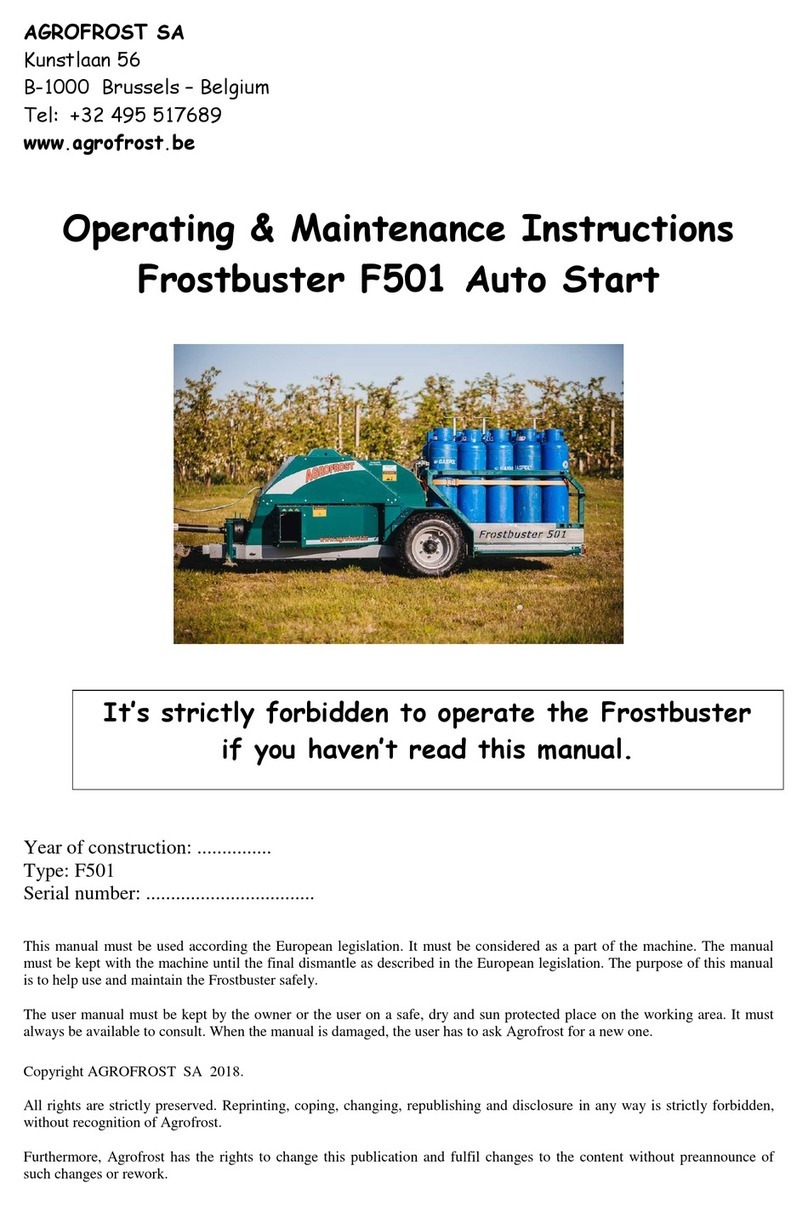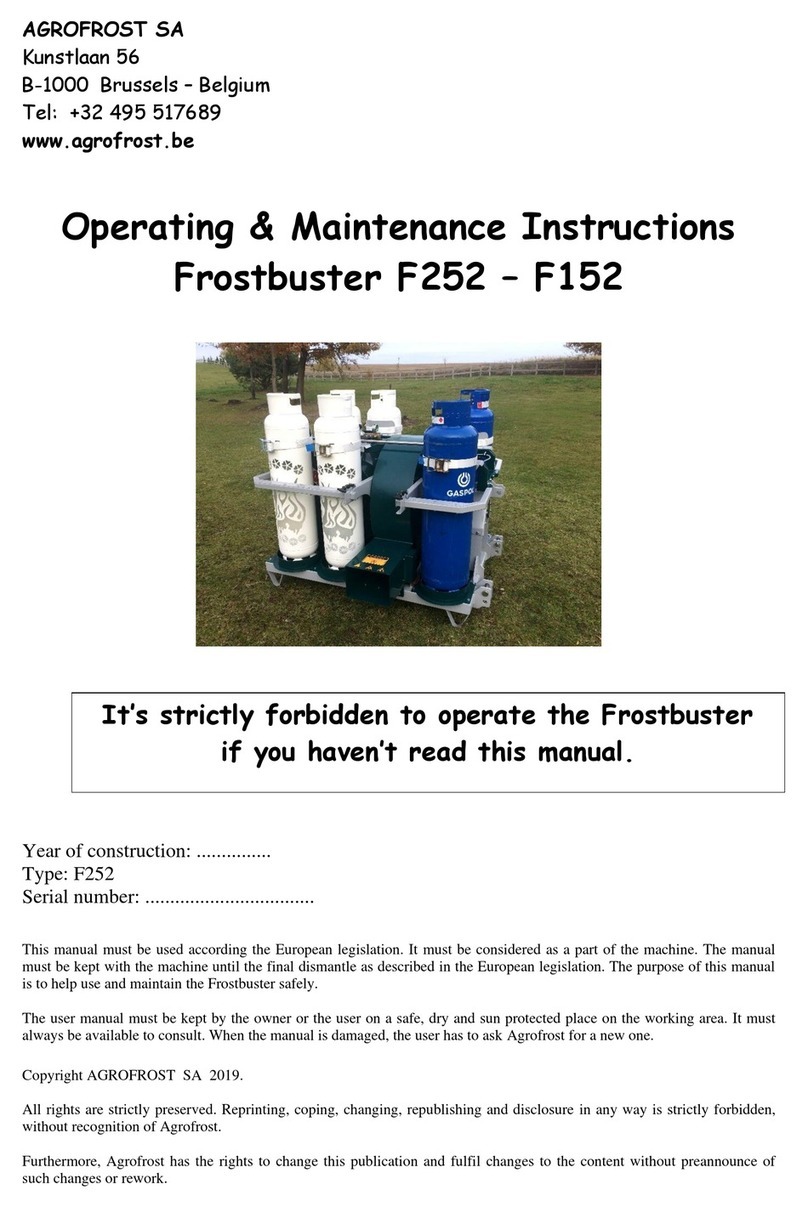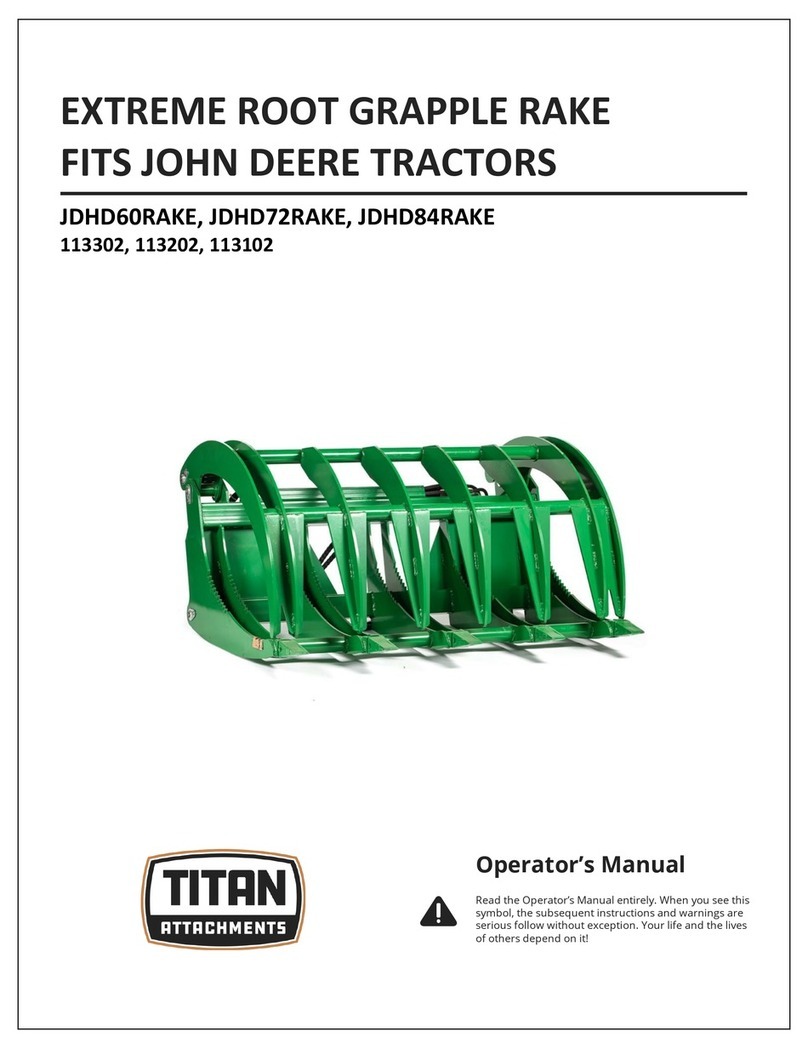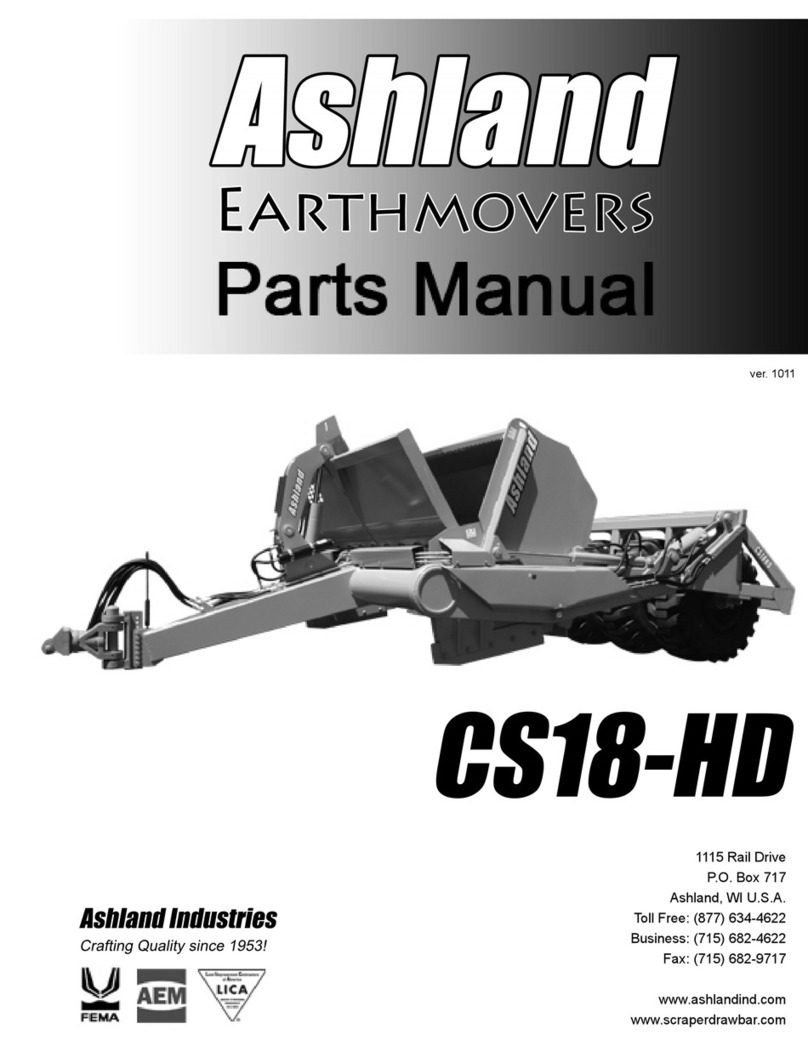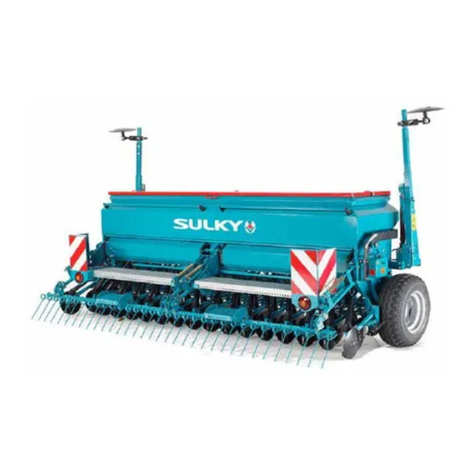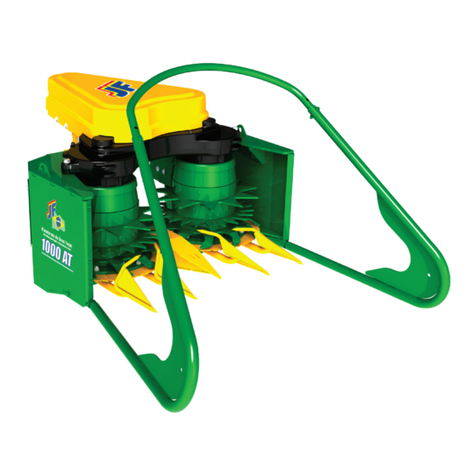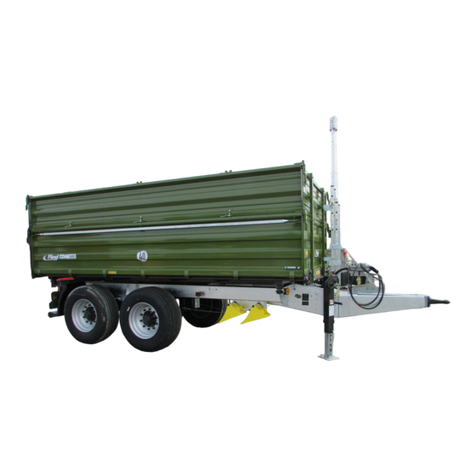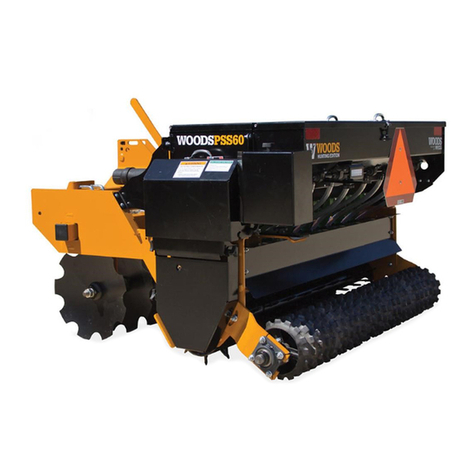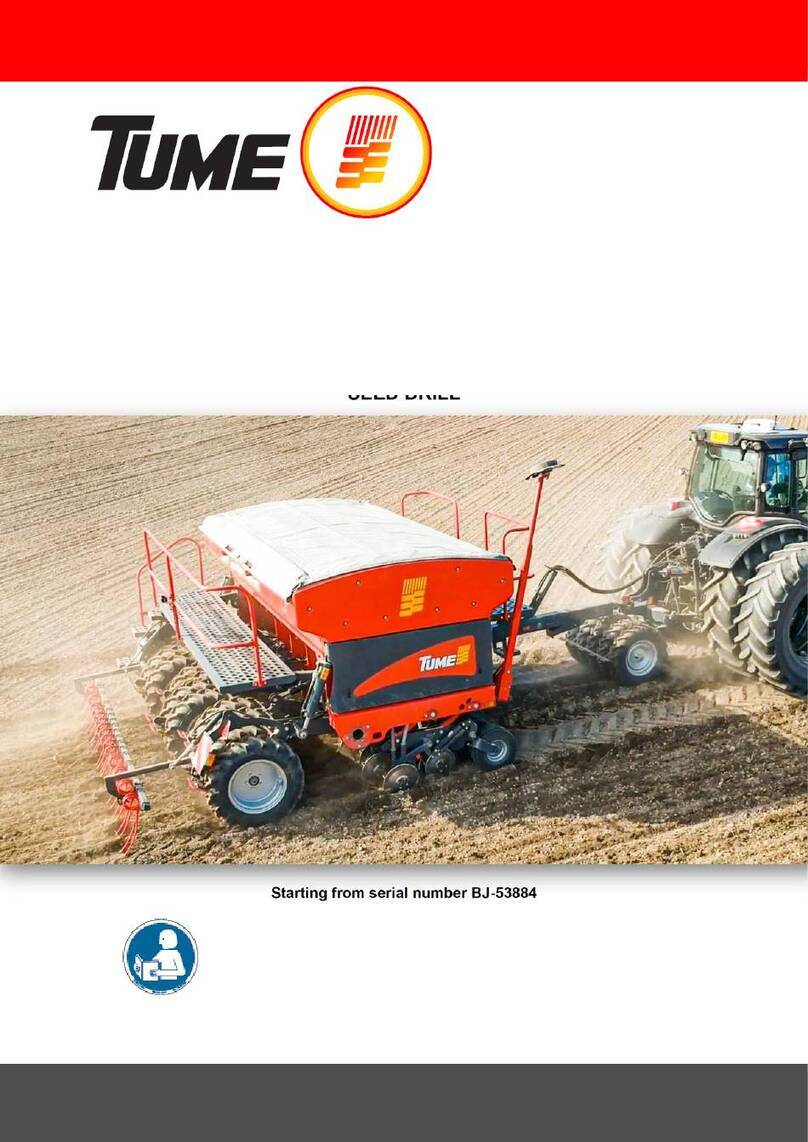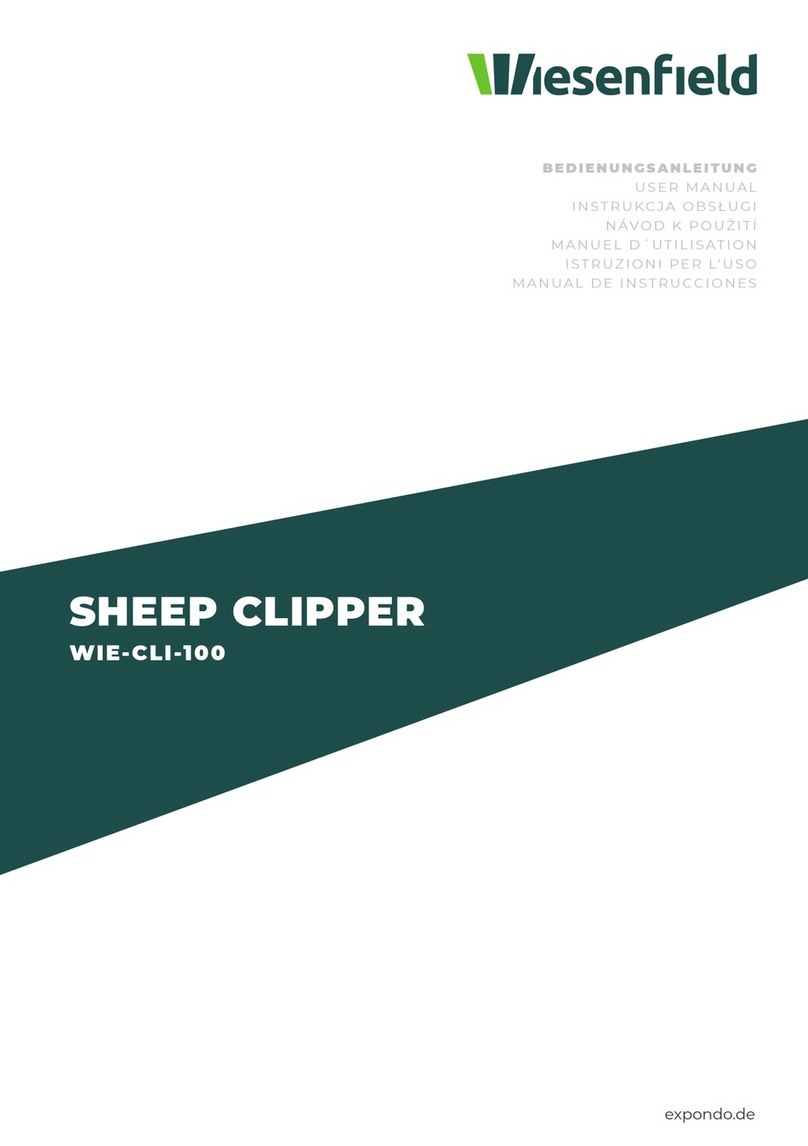AGROFROST FrostGuard Revolution S20 Installation and operation manual

~ 1 ~
Frostguard - Operating & Maintenance Instructions –www.agrofrost.eu
Operating & Maintenance Instructions
FrostGuard Revolution S20 & S30
It’s strictly forbidden to operate the FrostGuard
if you haven’t read this manual.
Year of construction: ...................
Type: S20 / S30
Serial number: ..................................
Make life easy: buy our AGROFROST Frost Alarm !
This manual must be used according the European legislation. It must be considered as a part of the machine. The manual
must be kept with the machine until the final dismantle as described in the European legislation. The purpose of this
manual is to help use and maintain the FrostGuard safely.
The user manual must be kept by the owner or the user on a safe, dry and sun protected place on the working area. It must
always be available to consult. When the manual is damaged, the user must ask Agrofrost for a new one.
Copyright AGROFROST NV 2022.
All rights are strictly preserved. Reprinting, coping, changing, republishing and disclosure are strictly forbidden without
recognition of Agrofrost SA.
Furthermore, Agrofrost SA has the right to change this publication and fulfil changes to the content without preannounce
of such changes or rework.

~ 2 ~
Frostguard - Operating & Maintenance Instructions –www.agrofrost.eu

~ 3 ~
Frostguard - Operating & Maintenance Instructions –www.agrofrost.eu
POINTS OF ATTENTION IN THIS MANUAL
Hint: to give suggestions and advice to ease certain tasks
Attention: a remark with extra information to call your
attention for possible problems
Warning: to call your attention for avoiding danger
ABOUT THE USERS OF THE FROSTGUARD
▪Required user characteristics.
Persons allowed to drive a tractor by law and familiar with the driving of a tractor may operate the
FrostGuard. They must be at least 18 years old and be able of all their physical and psychical
capacities. They must read this manual before using the FrostGuard.
Someone who has not read this manual cannot use the FrostGuard safely.
▪The profile of the user.
This user manual is created for two main groups:
-The user: the person who operates the FrostGuard
-The mechanic: the person who does the assembling, maintenance and repairs
Members of both groups must read this manual attentively before using the FrostGuard and before
doing any repairs or maintenance on the FrostGuard.

~ 4 ~
Frostguard - Operating & Maintenance Instructions –www.agrofrost.eu
1INTRODUCTION........................................................................................................................................5
1.1 Intended conditions of use of the FrostGuard....................................................................................................... 5
1.2 Improper use of the FrostGuard ........................................................................................................................... 5
1.3 Positioning the FrostGuard in the orchard, vineyard or field ............................................................................... 5
1.4 When to start? –When to stop?............................................................................................................................ 5
2SAFETY........................................................................................................................................................6
2.1 Important: not to be used in closed areas ............................................................................................................. 6
2.2 Safety and health risks: residual risk .................................................................................................................... 6
2.3 Safety precautions ................................................................................................................................................ 7
2.4 Safety advice on maintenance, repairs and storage .............................................................................................. 8
2.5 Explanation pictograms........................................................................................................................................ 8
3TRANSPORT AND STORAGE.................................................................................................................9
3.1 Transport .............................................................................................................................................................. 9
3.2 Storage.................................................................................................................................................................. 9
4FIRST USE AND PREPARATION .........................................................................................................11
4.1 First use .............................................................................................................................................................. 11
4.2 Set up the FrostGuard with 4 gas cylinder holders on the machine.................................................................... 11
4.3 Set up the FrostGuard with container for 5 or 6 gas cylinders. .......................................................................... 11
4.4 Set up the FrostGuard with a gas tank of 300 kg, 500 kg or bigger. .................................................................. 12
4.5 Setting the gas pressure. ..................................................................................................................................... 12
5POSITIONING OF THE MACHINES IN THE ORCHARD / VINEYARD. ......................................13
5.1 Orchards............................................................................................................................................................. 13
5.2 Vineyards ........................................................................................................................................................... 13
6OPERATING THE FROSTGUARD. ......................................................................................................14
6.1 The controls........................................................................................................................................................ 14
6.2 Start up and stop Procedure................................................................................................................................ 15
6.2.1 The Main Control Box.............................................................................................................................. 15
6.2.2 Starting Procedure..................................................................................................................................... 15
6.2.3 Stopping Procedure................................................................................................................................... 17
6.3 During operation................................................................................................................................................. 17
6.4 Replacing the gas cylinders during operation..................................................................................................... 17
7MAINTENANCE –CLEANING..............................................................................................................18
7.1 Cleaning ............................................................................................................................................................. 18
7.2 Maintenance ....................................................................................................................................................... 18
7.2.1 Burner ....................................................................................................................................................... 18
7.2.2 Engine....................................................................................................................................................... 18
7.2.3 Annual maintenance to prevent corroding................................................................................................ 19
7.2.4 Propane hoses: obligatory to replace every 5 years .................................................................................. 19
7.3 Warranty –Scrapping –Spare parts list. ............................................................................................................ 19
7.3.1 Warranty ................................................................................................................................................... 19
7.3.2 Scrapping.................................................................................................................................................. 19
7.3.3 Parts list .................................................................................................................................................... 19
8EC DECLARATION OF CONFORMITY..............................................................................................20

~ 5 ~
Frostguard - Operating & Maintenance Instructions –www.agrofrost.eu
1Introduction
1.1 INTENDED CONDITIONS OF USE OF THE FROSTGUARD
The FrostGuard is a rotating motor driven machine equipped with a powerful fan and a gas burning installation on the
side. It generates a lateral laminar flow of hot air to treat crops and trees with.
The FrostGuard may only be used outdoors where there is natural ventilation.
At the end of the season, the FrostGuard needs to be stored indoor with the propane bottles removed from the machine.
The propane bottles must be stored outside, according the prescriptions of the fire insurance company.
1.2 IMPROPER USE OF THE FROSTGUARD
The FrostGuard may not be used indoors or outdoors in a closed area without natural ventilation.
It is strictly prohibited to use the machine if not all safety requirements as described in Chapter 2, are complied.
The FrostGuard cannot be used, when one or more of the following parts are missing, loose, damaged or incomplete:
-Air outlet
-All the doors / side panels
-A fully loaded battery
Furthermore, it is strictly prohibited:
- to use the FrostGuard on slopes with gradients of more than 20%;
- to carry a charge of any kind in any circumstances on the machine;
- to transport persons or loads on the machine;
- to weld or to make any changes whatsoever on the original design of the FrostGuard.
1.3 POSITIONING THE FROSTGUARD IN THE ORCHARD, VINEYARD OR FIELD
Ask your dealer for the ideal setup of the machines. Or send a plan of your orchard/vineyard by e-mail to
1.4 WHEN TO START? –WHEN TO STOP?
The starting temperature depends on the flowering stage.
Once the buds are in balloon stage or in full flowering, it’s very
important that the machine is started up before the wet temperature
drops below 0 °C (+0,3 °C).
When the wet temperature outside the treated orchard/vineyard is
positive again, the machine may be stopped.
If you use the Auto Start System, we strongly recommend putting the
starting temperature at + 0.5 °C. (33°F)

~ 6 ~
Frostguard - Operating & Maintenance Instructions –www.agrofrost.eu
2Safety
In this chapter, the FrostGuards most important safety aspects will be explained. It is essential that everybody who works
with the FrostGuard reads attentively the contents of this chapter.
The most important safety and health risks related for using the FrostGuard are listed in paragraph 2.2. The FrostGuard
is designed to reduce these risks as much as possible.
The safety precautions to be observed and to be taken by the FrostGuard user are listed in paragraph 2.3.
The safety advices for technicians come up in paragraphs 2.4 and the symbols found on the FrostGuard are clarified in
paragraph 2.5.
2.1 IMPORTANT: NOT TO BE USED IN CLOSED AREAS
It is not allowed to use the FrostGuard in a closed area, because of three reasons:
- The burner consumes oxygen. Therefore, the supply of fresh air is very important.
- The engine produces carbon monoxide. This is an odorless, colorless, poisonous gas. Breathing carbon
monoxide can cause nausea, fainting or death.
- If gas would escape because of a gas leak, it could create life threatening situations in a closed area
because of the danger of explosions.
2.2 SAFETY AND HEALTH RISKS: RESIDUAL RISK
The residual safety- and health risks related to parts of the FrostGuard are being mentioned below together with a series
of measures that are taken to keep these residual risks as little as possible.
•Presence of propane gas (= combustible)
-Risk of explosion in closed space has been averted by use of safety components and the explicit ban on indoor
use.
-The design of the FrostGuard also reduces the risk of the presence of accumulated gas. If the FrostGuard is
working with all the cover plates present, the inlet air stream will flow throughout the FrostGuard and carries
any possible accumulated gas through the fan before ignition has started.
-Various safety components are built in the gas installation. The suppliers of these components ensure that have
been inspected by an official inspection service.
-Ignition of the gas is built in and works from a distance. The user ignites the machine in a safe way from a safe
position.
-An electric valve is built in. It stays only open automatically when the burner is working. If the flame goes out,
the valve will close immediately.
-When the energy supply is cut off, the machine cannot function, because the pilot will have gone out.
•Presence of propane under pressure.
There are 3 pressure regulators for pressure relief.
-There is one pressure regulator outside the machine. This should be set to 1.5 bar.
-The first one inside the machine is sealed and reduces the incoming pressure 1 bar. There is no need to alter the
preset value.
-The second regulator inside the machine is used to adjust the air temperature.
•Presence of high temperatures
-At the ignition on the inlet of the burner: the ignition is entirely shielded from contact with the user by the isolated
inlet. There's no chance for contact with the ignition flames.
-At the outlet of the fan: when the machine is working, the flow of the air prevents touching the inside of the
outlet of the fan. When the user stops working with the machine, he must leave the fan running for at least 2
minutes, so the additional outlet of the fan can cool sufficiently (30°C). There is a thermometer and a warning
pictogram on the outlet of the machine. So, the user can check the temperature before he starts to store the outlet.
However, there is no shielding to prevent the user to touch the fan outlet of the machine.

~ 7 ~
Frostguard - Operating & Maintenance Instructions –www.agrofrost.eu
•Uncontrolled use of the FrostGuard
-The use of control panels simplifies and secures the operation of the FrostGuard. Explanation is given in chapter
5.
•There are 4 heat sensors incorporated, all at the outlet of the fan.
a. One heat sensor will shut down the machine when the temperature exceeds 150 °C.
b. One heat sensor is connected to the temperature gauge to show the working temperature.
c. One heat sensor will activate the alarm when the working temperature exceeds 120 °C.
d. One heat sensor will activate the alarm when the working temperature drops below 50 °C.
•Presence of rotating parts
-Covering the exhaust pipe isn’t possible because this exhaust is needed for applying a laminar air flow. Because
of this, there is an extra sensor that controls if the exit pipe is mounted.
-S20 models: When the 4-pole plug next to the exit pipe is not inserted, the engine will not start. If the exit pipe
is taken away during operation, the engine will stop immediately.
•Dangerous situations involving third parties
-A fixed safety zone of 10 meters around the FrostGuard must be observed: no other people but the user may be
in that safety zone.
When disconnecting the propane supply to the burner, for any reason, always keep the machine running for
another 3 minutes to remove any amassed gas and to cool down the heat sensors of the electric valve.
Only after the electric valve has closed automatically other people may enter the safety zone.
2.3 SAFETY PRECAUTIONS
Before use
First read attentively the instructions in the manuals of both the FrostGuard. The user has to be acquainted with operating
the controls of the machine.
•The guards/doors must all be in their place. The FrostGuard cannot be used, when one or more of the guards/doors
are missing, loose, damaged or incomplete.
•Check the propane connections for leaks with the leak spray.
During use
•When the machine is activated, make sure that no other people come within the safety zone, being 10 meters around
the machine. Keep children away from the machine. Do not let them without supervision if they could come within
the safety zone, being 10 meters around the machine.
•Remain within hearing distance when the machine is working. The acoustic alarm could go off, indicating that there
is need for intervention.
•Do not let the machine work without all the cover plates: it is important for the cooling of the engine that all the
plates/doors are in place.
•Beware of the fact that the entire machine is rotating. Therefore, don't come to close. You might influence the working
of the machine.
•Always keep the engine running at a stable pace (full throttle). When the number of revs lowers, the exhaust
temperature will rise sharply. The guards on the exhausts will also heat up, which results in potential danger of burns.
EXTRA WARNINGS:
DO NOT PUT YOUR HANDS IN THE EXHAUST FAN

~ 8 ~
Frostguard - Operating & Maintenance Instructions –www.agrofrost.eu
When changing the propane bottles and ending operation
•Always close the propane bottles after use, and before changing them on the machine.
•Use leak spray to check the connections of the propane cylinders for leaks after connection the gas hoses to the bottles.
2.4 SAFETY ADVICE ON MAINTENANCE, REPAIRS AND STORAGE
•All screws and nuts must be tightened firmly, to keep the machine safe and in optimal condition.
•The FrostGuard must be stored inside, but not with the propane bottles on it. Store the FrostGuard horizontally in a
dry place.
•Always use genuine spare parts. Using non-genuine spare parts can enhance the chances of damage, even if they fit
on the machine.
•Replace damaged warning and instruction stickers.
•All the flexible propane hoses must be replaced every 5 years.
2.5 EXPLANATION PICTOGRAMS
FLAMMABLE
MATERIALS
HOT SURFACE
MOVING PARTS
CAUTION - DANGER
FIRE: OPEN FLAMES
AND SMOKING
PROHIBITED

~ 9 ~
Frostguard - Operating & Maintenance Instructions –www.agrofrost.eu
3Transport and Storage
3.1 TRANSPORT
•Before transporting or moving the machine, make sure it’s in the
transport position. You can rotate the machine –WITHOUT THE
ENGINE RUNNING - by pushing on the black button on the control
box ‘C’ (see picture).
•When you want to transport the machine by road, you need to fix the
machine firmly onto the transportation vehicle.
•If it is necessary to hoist the FrostGuard, you can buy a set of liftings eyes
that can be mounted on the machine.
•When you transport the machine towards the field, the FrostGuard can be
moved with a tractor that is equipped with a forklift. The forks of the forklift
should support the main frame.
•Do not drive faster than 5 km/hour during transport in the field.
3.2 STORAGE
During the season
During the period of use, you can leave the FrostGuard standing in the field for a while. The FrostGuard is protected
against all weather conditions.
After the season
Make sure that the FrostGuard is cleaned as described in chapter 7.
Store the FrostGuard in a covered, dry place and horizontally, even when storing it for a short while.
Store the FrostGuard in a place where you don’t need to cover it, because underneath a cover arises condensation. In this
way, the risk of absorbing moisture by insulation incorporated in the machine is avoided.
The propane bottles must be removed every time the machine is stored indoor.
The propane bottles or tanks must be stored outdoor, according to the prescriptions of the fire department
and your insurance company.
When you store the FrostGuard during summer and autumn, it is better that you take the battery out of the FrostGuard.
You can use it elsewhere or you can use a trickle charger to keep it in the best condition.
To take out the battery, you just need to unscrew the battery connectors.
First disconnect the negative pole with the black wire, then the other one.
To install the battery again, you can't connect this in a wrong way, because one of the connectors is slightly bigger than
the other.
Reconnect the positive pole and the red wire first.
C

~ 10 ~
Frostguard - Operating & Maintenance Instructions –www.agrofrost.eu
Positive pole (red wire)
Negative pole (black wire)

~ 11 ~
Frostguard - Operating & Maintenance Instructions –www.agrofrost.eu
4First use and preparation
Mount all the pieces that are delivered separately.
The FrostGuard can be equipped with different systems for the propane bottles.
Every system is delivered with its own mounting instructions. Follow these instructions.
S20: Pay special attention to the swivel connection at the top of the FrostGuard in case you do not use the
4 bottle holders that are mounted on the machine. The flexible propane hose that comes from the propane
tank needs to be high enough above this point because the FrostGuard is turning around. By turning
around, it could get stuck if the hose is not installed high enough.
4.1 FIRST USE
You need to install the FrostGuard properly. Make sure it is placed in its best possible position: parallel
or as close as possible to parallel with the terrain, if the slope is not more than 15%. Otherwise, you
must level out the machine until the angle is not more than 15%.
For obtaining the best results, it needs to be levelled with its surroundings as well: for the best results
the air needs to travel close to the ground over a distance of ± 50 to 60 meter.
Make sure everything is tested in advance: use the leak spray to test the propane connections.
Check if the battery is connected.
Supply enough spare propane bottles. Make sure that these are within easy reach, so changing them
can be done as quickly as possible. Put the necessary tool out as well: a 28 mm open-end spanner. (In
some countries, the open-end spanner maybe of a different size as 28 mm)
After connecting the gas hoses, check the gas connections with the leak spray.
4.2 SET UP THE FROSTGUARD WITH 4 GAS CYLINDER HOLDERS ON THE MACHINE.
On all models, it’s possible to mount 4 bottle holders for the propane bottles.
-Put the cylinders in the holders and fix them with the straps.
-Connect all the cylinders to the gas hoses.
-After connecting the gas hoses, check the propane connections with
the leak spray.
-You need to use them all together, otherwise the cylinders will
freeze. (open all the valves)
-Make sure there is enough propane to last all night. (consumption = 10 kg / h)
4.3 SET UP THE FROSTGUARD WITH CONTAINER FOR 5 OR 6 GAS CYLINDERS.
-Put the cylinders in the container and fix them with the straps.
-Connect all the cylinders to the gas hoses.
-Make sure to connect the heating pipe to the container, otherwise the cylinders will freeze.
-After connecting the gas hoses, check the gas connections with the leak spray.
-You need to use the gas cylinders all together, otherwise the cylinders will freeze.
-Make sure there is enough gas to last all night.
+

~ 12 ~
Frostguard - Operating & Maintenance Instructions –www.agrofrost.eu
4.4 SET UP THE FROSTGUARD WITH A GAS TANK OF 300 KG, 500 KG OR BIGGER.
It’s also possible to use bigger gas tanks for the gas supply. Because the distance from the gas tank to the machine has a
big influence on the gas supply, please ask the manufacturer how to set it up if your tank is more than 5 meters away.
A special heating pipe can be delivered if using a thank, smaller than 500 kg. The tank needs to be warmed with the
special heating pipe, and the distance between tank and machine may not exceed 5 meters. You need a special gas hose
for the gas supply (and a special heating pipe to warm up the tank if the tank is smaller than 500 kg)
If you want to use big storage tanks, with an underground pipeline network, please ask the manufacturer how to set it up.
4.5 SETTING THE GAS PRESSURE.
If you use a bottle rack, container or a tank, near the machine or on a larger distance, you always need a pressure regulator
at the beginning of the propane line. (This propane line can be a rubber hose or a PE-line).
The gas pressure at the entrance of the machine must at 1.5 bar.
This is the pressure whilst the engine is running, the burner is ignited, the temperature outside is approx. 0 °C and
the temperature of the burner is between 70 and 90 °C. (158 and 194 °F)
To adjust this pressure, the outside temperature should be around 0°C. Procedure to follow:
-Start up the machine
-Ignite the burner
-Let the machine run for 5 minutes and check the temperature. This must be between 70 and 85°C (158 and 194
°F).
-Adjust the pressure regulator - WHILST THE MACHINE IS WORKING - to obtain a pressure of 1.5 bar (20
psi) at the entrance of the machine.
Before you open the gas bottles, make sure that they are in a vertical position for at least 10 minutes.

~ 13 ~
Frostguard - Operating & Maintenance Instructions –www.agrofrost.eu
5Positioning of the machines in the orchard / vineyard.
5.1 ORCHARDS
The distances to respect between multiple machines depend on the density of the trees.
-If trees are planted 4 x 4 or 4 x 5 or 5 x 5 or … the FrostGuard will protect a round area of
approx. 1 hectare.
-If trees are planted 0.5 x 3 or 1 x 3.5, the machine will protect an oval area of approx. 70 x
110 m
5.2 VINEYARDS
-In vineyards, we recommend keeping a maximum distance between the machines of 80
meters.
-Be aware that vines that are very close to the ground are more difficult to protect than vines
of which the lowest buds/leaves are at a height of 60 or 80 cm.
-It’s always helpful to put 1 row of paraffin candles on the wind side. When temperatures
drop below -3 °C, or in case of wind, it’s very helpful to put one row of candles on the
complete outside of the vineyard.

~ 14 ~
Frostguard - Operating & Maintenance Instructions –www.agrofrost.eu
6Operating the FrostGuard.
6.1 THE CONTROLS
A
main switch / key
With this switch the FrostGuards engine can be started or turned off.
0 = all functions shut off
1 = electric power on control box
2 = to start the engine
B
Screen
Shows status of the machine. (RPM of engine, burner temperature etc.)
C
Push button
To rotate the machine into transport position.
D
Frist Regulator
This regulator is sealed and preset in the factory. It should give a reading of
approximately 0.9 –1.1 bar whilst the machine is operating.
E
Second Regulator
This is regulator is used to adjust the working temperature of the burner. The
temperature must be between 75 and 85 °C.
F
Gas filtre
Gas filtre; can be cleaned
G
Alarm switch
To switch acoustic alarm on/off
B
A
C
G
E
D
D
F
E

~ 15 ~
Frostguard - Operating & Maintenance Instructions –www.agrofrost.eu
6.2 START UP AND STOP PROCEDURE.
6.2.1 The Main Control Box
The control box has a screen, a key, a switch and a push button.
-The screen (B) shows all relevant information
-The key (A) is used to start the engine
-The push button (C) is used to rotate the machine manually.
-The switch (G) is to activate the acoustic alarm.
S20 only: before you start, place the exit pipe in the gliders and
plug the 4-pole plug into the 4-pole socket. If the plug is not
inserted, the engine will not start.
S30 only: make sure that the exit pipe does not point towards
you when you start the machine. In that case, first make it turn
away from you by pussing the black button “C” on the control box.
6.2.2 Starting Procedure.
1. Open all the gas cylinders or gas tanks (propane supply).
2. Turn the key (A) to position ‘1 - ON’.
The screen will show “Rpm=0 –Temp=..°C, ..°F - Burner=Off”
3. Press the choke 4 times during 1 second.
4. Start the engine by turning the ignition key (A) to position ‘2 –
START’. Let the engine run idle for 1 minute to warm it up. The
that the burner is off.
5. Put the ‘gas throttle’ to Full Throttle. The engine accelerates
and the burner will ignite after a few seconds. The screens show
that the burner is igniting.
6. If the burner does not ignite from the first time, the screen will
show “Burner-Fault” and the machine will do two more attempts
to ignite. This will also be shown on the screen, where you can
read “Try=2” or “Try=3”. Normally, the burner ignites from the
first time.
C
5
3
6
6
5
2
B
A
C
G
4

~ 16 ~
Frostguard - Operating & Maintenance Instructions –www.agrofrost.eu
7. When the burner has ignited, it will
be shown on the screen “Burner –
Ok”. The yellow and green LED on
the blue box (burner controller) light
up. Go to point number 10.
8. If the burner did not ignite, the
screen will show following message:
“General-Fault”. In this case, put the
gas throttle to IDLE and turn the key to ‘0 – OFF’.
9. Restart from point 4. When you put the gas throttle to Full Throttle,
check the pressure on the second pressure regulator (E). Probably the
gas pressure is too low and there is not enough gas supply to ignite the
burner. While the burner ignites, the gas pressure should be at least 0.5
bar. If this is not the case, adjust the pressure.
10. Check the gas pressure on the sealed pressure regulator “D” (=the left
one). It should indicate approx. 0,8 bar.
11. Check the gas pressure on the other pressure regulator “E”. It should
indicate approx. 0,5 bar.
12. Check the temperature with the small digital thermometer.
There is a small hole on top to the outlet pipe of the fan, near the
fan’s exit. Put the thermometer in this hole to verify the
temperature. (The temperature is also shown on the control box)
13. The correct temperature is between 75 °C and 85 °C. It can take up
to 10 minutes before the machine is warmed up so do not start
changing the gas pressure immediately after start-up to change the
temperature.
14. If necessary, adjust the gas pressure “E” to get a temperature of 80
°C. Do not exceed 85 °C. After adjusting the gas pressure, wait
long enough until the temperature is stable before you make another correction. Check the temperature at the
beginning of the fan’s exit pipe with the small digital temperature to
read the exact temperature.
15. ATTENTION: when the burner has started, it’s important that the
speed of the engine is set to full speed. If this is not than within 10
seconds, the burner will shut off, and the screen will show ‘Burner-
Off-Low Speed’.
16. ATTENTION: if the temperature goes above 150-170 °C, as shown
on picture 16, the burner will shut off shortly after.
17. Once the machine is running, you can switch the acoustic alarm on,
using the switch “G” on the control box. The alarm will sound when
the temperature is too low or too high. Do not switch it on before the
temperature has reached his normal operating temperature, otherwise
the alarm will sound immediately.
7
7
8
9
E
14
E
15
16
15

~ 17 ~
Frostguard - Operating & Maintenance Instructions –www.agrofrost.eu
6.2.3 Stopping Procedure.
1. Switch the alarm off - switch “G” - when it is active.
2. Put the ‘gas throttle’ down to “IDLE”. The burner will stop. The screen will show “Burner-Off –Low Speed”.
3. Let the engine run IDLE for at least 3 minutes to cool down the fan.
4. Turn the key on the control box to “0 - OFF”.
5. Close all gas cylinders.
6. Before transporting or moving the machine, make sure it’s in the transport position. You can rotate the
machine –WITHOUT THE ENGINE RUNNING - by pushing on the black button (C) on the control box.
6.3 DURING OPERATION
Keep all doors closed during operation. If some doors are left open, the cooling of the engine might be compromised.
Check the temperature after 10 minutes and adjust the pressure to obtain an air temperature of 80 °C. If the temperature
remains stable, you can leave the FrostGuard.
The normal working pressure will be approx. 0,5 bar. However, this could change depending on air temperature,
humidity, wind etc. Always let the engine run at full throttle.
6.4 REPLACING THE GAS CYLINDERS DURING OPERATION
When the temperature drops 20 degrees in a few minutes, the propane cylinders must be replaced. It is of course
recommendable to keep the replacing time as short as possible, and below 10 minutes.
1. Switch the alarm off - switch “G” - when it is active.
2. Put the ‘gas throttle’ down to “IDLE”. The burner will stop. The screen will show “Burner-Off –Low Speed”..
3. Let the engine run IDLE while you change the bottles.
4. Disconnect the propane bottles and take them out of the holders or container.
5. Put new bottles in. Fix all bottles with the straps, connect all the bottles and open them ALL.
6. Check the connections with the LEAK-spray. To start the FrostGuard again, the start procedure must be
followed.

~ 18 ~
Frostguard - Operating & Maintenance Instructions –www.agrofrost.eu
7Maintenance – Cleaning
7.1 CLEANING
You can clean the outside of the FrostGuard by hand, but you may not use a high-pressure cleaner. You can
use a garden hose, but not nearby electrical parts or sensors. Don't use water inside of the machine.
7.2 MAINTENANCE
7.2.1 Burner
The burner does not require any maintenance.
7.2.2 Engine
There is a manual for the engine, provided by the manufacturer of the engine. As the manual of the engine is
also part of the manual of the machine, you need to follow all the instructions written in that manual to.
does not replace any other actions written in the manufacturer's manual.
The most important issues about the engine are:
Check the oil level every 20 hours.
Replace the oil of the engine every 75 hours of operation.
If the machine did not operate 75 hours a year, you need replace
the oil every year in the beginning of the working season.
The drain hole of the engine is just above a metal angle bar that
collects the oil. Place a reservoir at the end of the bar.
Clean the air filter with compressed air every 75 hours of operation.
Replace the air filter every 225 hours of operation.
If the machine did not operate 75 hours a year, you must clean it every year in
the beginning of the working season.
Mandatory replacement is every 3 years.
Clean the gas filter when necessary !!

~ 19 ~
Frostguard - Operating & Maintenance Instructions –www.agrofrost.eu
7.2.3 Annual maintenance to prevent corroding
To prevent corroding, these parts need to be sprayed with oil (WD40) once a year.
-all key locks on the machine need to be treated as well.
7.2.4 Propane hoses: obligatory to replace every 5 years
The propane hoses need to be replaced every 5 years. There is a date mark on each hose that indicates the year of
fabrication. You are obliged to contact your local supplier or Agrofrost to have them replaced before they expire. For
instance: hoses with 2012 written on it should be replaced before end 2017.
7.3 WARRANTY –SCRAPPING –SPARE PARTS LIST.
7.3.1 Warranty
The warranty covers the parts that are defective from the start, and that are produced by AGROFROST. This warranty
expires when it is a matter of normal wear, when a malfunction is caused by incorrect operation or maintenance of the
machine, in case the user has not observed the instructions in the manual, or when non-genuine parts, not produced by
AGROFROST are used.
We do not accept complaints about changes that will be introduced in the future to improve the machine.
It is important that the document, called “INSTALLATION PROCEDURE” is filled up and send back to the address of
the manufacturer: AGROFROST NV –Kunstlaan 56 –1000 Brussels - BELGIUM
If this document is not sent back, the manufacturer reserves the right to cancel any warranty.
7.3.2 Scrapping
The following table gives an overview of the correct way of disposal of the different parts, in case the FrostGuard has to
be dismantled.
Part Way of disposal
Bearings scrap
Oil from the gearbox chemical waste
Frame and cover plates scrap
Screws, bolts, washers scrap
Gaskets container for synthetic material
Insulation construction / building waste
7.3.3 Parts list
If you need a parts list, you can ask for it at the manufacturer.

~ 20 ~
Frostguard - Operating & Maintenance Instructions –www.agrofrost.eu
8EC Declaration of Conformity
EC Declaration of Conformity.
We declare under our own responsibility that the machine complies with the safety and health
requirements established by the European Directive 2006/42/EG.
EN standard codes:
BS EN 1672-2:2005+A1:2009 ; BS EN ISO 14123-2:2015 ; BS EN ISO 12100:2010 ;
BS EN 1005-1:2001+A1:2008 ; EN 894-1:1997+A1:2008 ; BS EN 1037:1995+A1:2008 ;
BS EN ISO 13857:2008 ; BS EN 60204-1:2006+A1:2009 ; BS EN ISO 13850:2006 ;
BS EN ISO 13850:2015 ; BS EN 61310-1:2008 ; BS EN ISO 14119:2013 ;
BS EN ISO 13732-1:2006
Manufacturer : Agrofrost S.A.
Address : Kunstlaan 56 –1000 Brussels - Belgium
Telephone : +32 495 517689
Fax : +32 3 2958428
Authorized representative : Patrik Stynen
Address : Kunstlaan 56 –1000 Brussels - Belgium
Machine : FrostGuard Revolution Type ……………
Serial number : ………………………
Production date : ………………………
Year in which CE mark was affixed : ………………………
Signature:
Patrik Stynen
Director
This manual suits for next models
1
Table of contents
Other AGROFROST Farm Equipment manuals
Popular Farm Equipment manuals by other brands
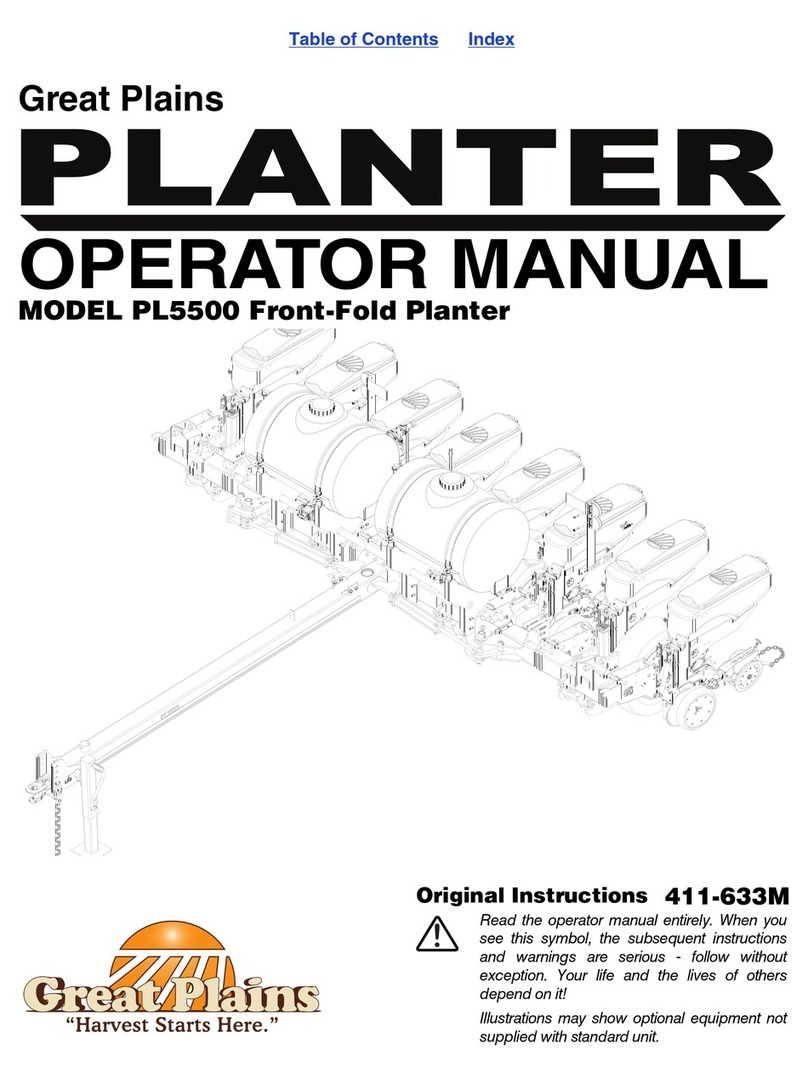
GREAT PLAINS
GREAT PLAINS PL5500 Operator's manual
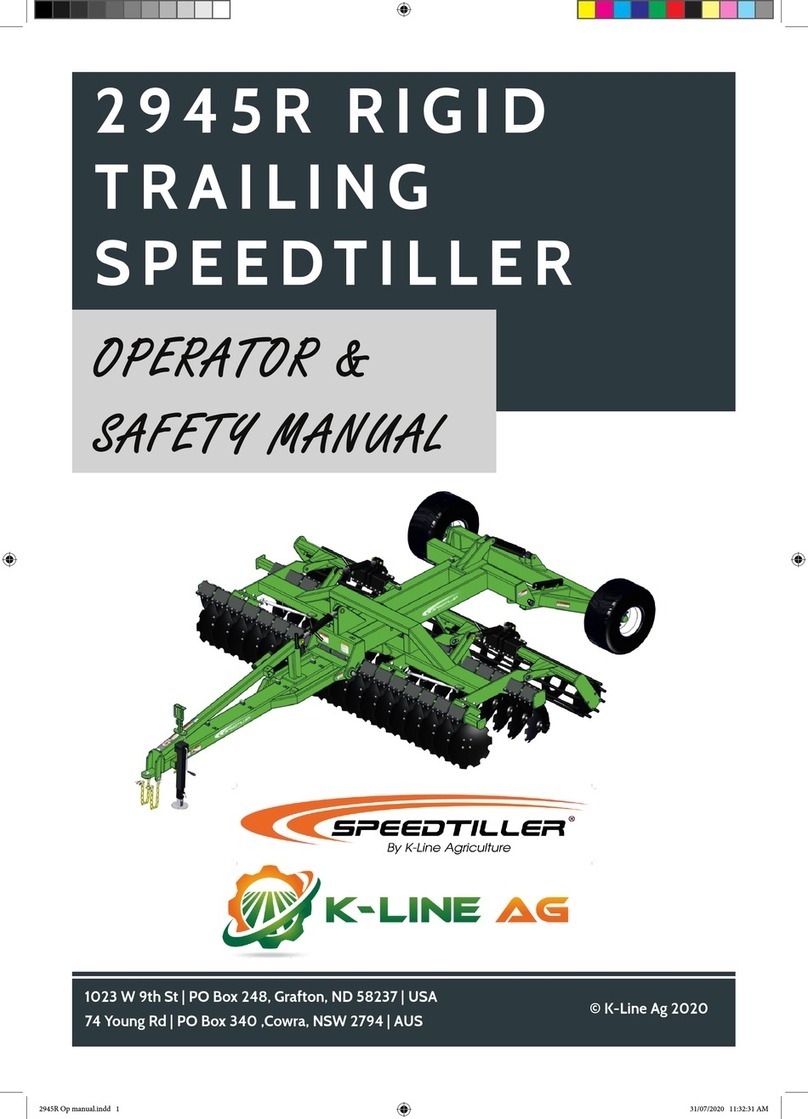
K-Line
K-Line Speedtiller 2945 Operators safety manual
Orthman
Orthman TRACKER IV Operator's manual
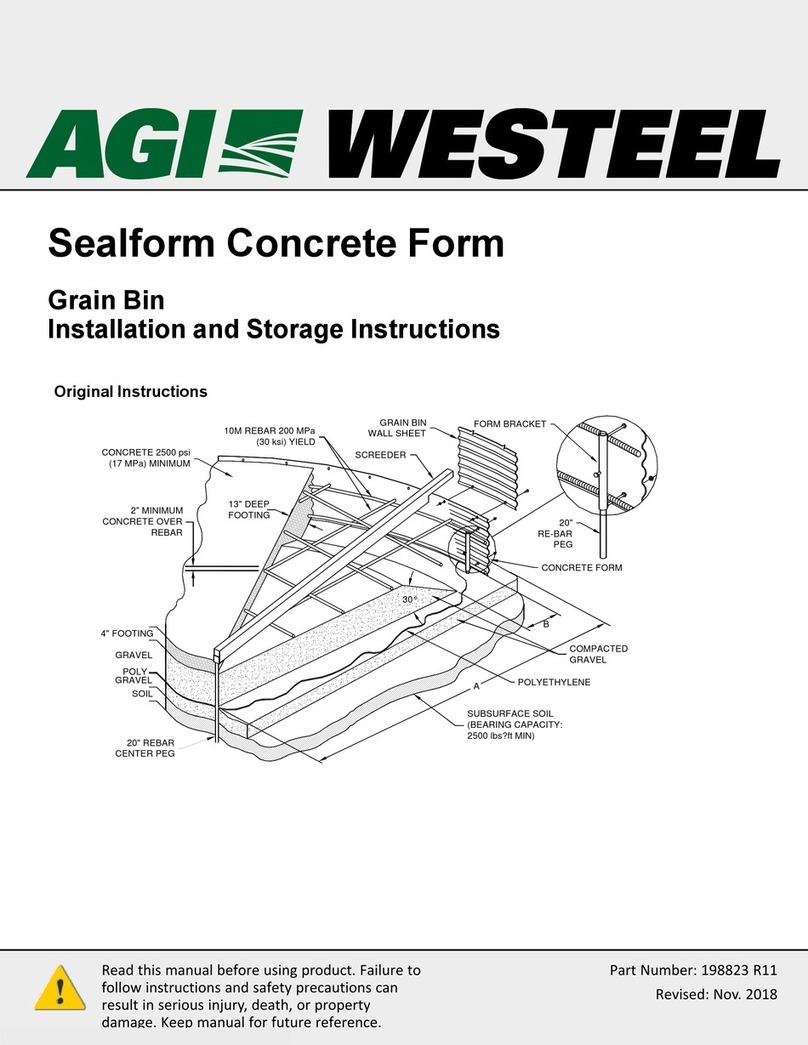
Westeel
Westeel Sealform Concrete Form Installation and Storage Instructions
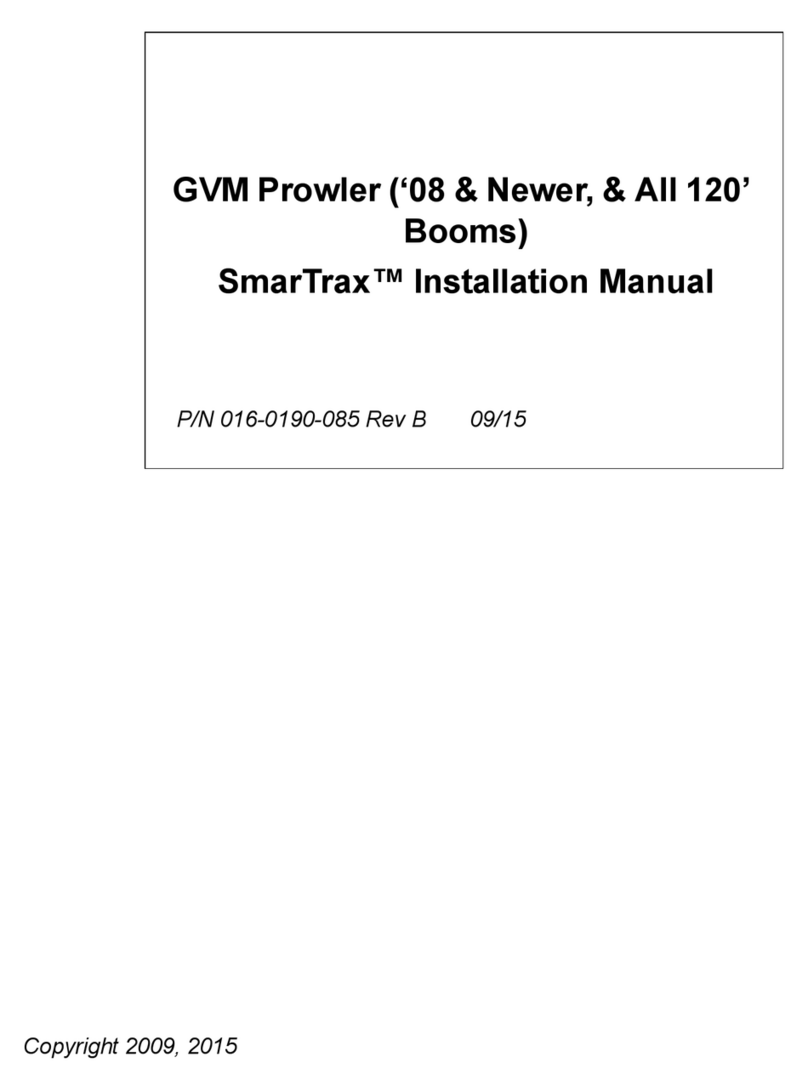
Raven
Raven SmarTrax installation manual
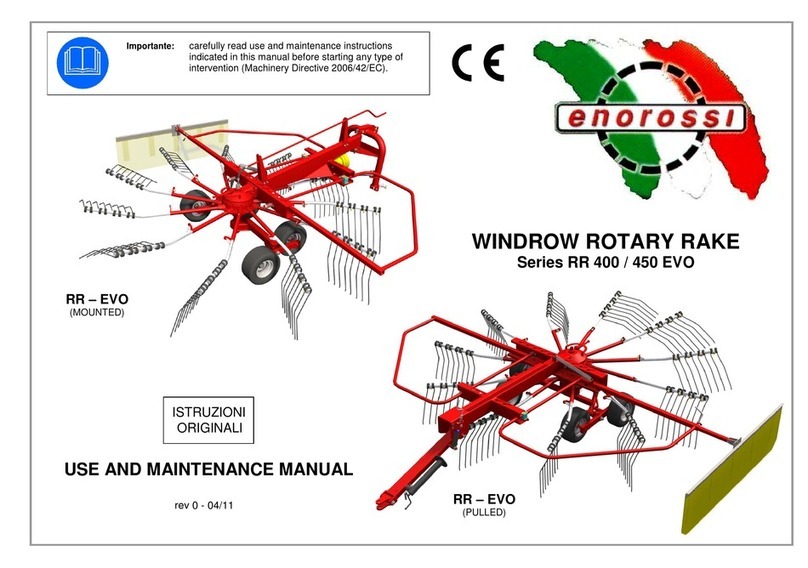
enorossi
enorossi RR 400 EVO Series Use and maintenance manual
